How to Optimise Product Descriptions at Scale Without Burning Out

A smarter approach to PDP optimisation
Product description pages (PDPs) have always mattered. They’re the place customers pause, evaluate, compare, and (hopefully) click “add to basket”. But the role of PDPs has shifted massively in the last couple of years. Search has changed. Customer behaviour has changed. And the expectations placed on product content have skyrocketed.
If you’re producing dozens, hundreds, or even thousands of product descriptions every month, you’ll know exactly how intense and repetitive it can be. We work with large retailers and big brands who live this reality every single day - juggling fast-moving catalogues, tight deadlines, limited resources, and a growing pressure to “get everything optimised”.
You’re not alone. And you’re definitely not imagining it.
This topic has become such a big talking point that when our Head of Strategy, Abbie Dando, covered it at BrightonSEO this October, the room was completely packed. So we decided to turn that session into a full, open-access guide for anyone who wants a practical, modern way to scale PDP optimisation without losing their minds.
In this guide, you’ll find:
What’s changed in ecommerce search (and what it means for PDPs)
What to optimise first (high-impact list)
What customers and AI care about
Step-by-step framework to scale product descriptions
Review of the best AI tools for PDPs
Tips to make your workflow smoother, faster and easier on your team

Why Product Description Pages Need a New Approach in 2026
Over the years, we’ve helped brands refine their PDP processes, rebuild their content workflows, and integrate SEO properly into product content.
Throughout all of that work, one thing has become very clear:
Traditional PDP processes can't keep up in the world of AI.
AI-driven search experiences, new discovery channels, higher customer expectations, and faster-moving product teams mean the old approach just doesn’t scale. PDPs need more detail. Teams need better support. Workflows need to be more efficient.
And when you’re managing hundreds of products across multiple categories, channels, and formats? You can’t solve that by “just working harder”.
A fresh approach to writing product description pages that actually convert is now essential - and that starts with understanding the new search landscape your PDPs are competing in.
Your Customers Aren’t Just Using Google Anymore
Even a few years ago, “optimising for search” meant optimising for Google. But the modern customer journey is far more scattered - and far more complex.
A single buying journey might include:
Seeing a product on TikTok
Comparing alternatives using ChatGPT
Checking YouTube reviews
Verifying price via Google Shopping
Clicking through to your PDP to double-check details
Eventually converting via organic, PPC, or social
Your product descriptions now work across all of these touchpoints - even if you didn’t design them that way!
Where people look for products today
Google Shopping
Google’s AI Mode
ChatGPT, Claude & other LLM search tools
AI agents comparing products automatically
TikTok search
TikTok Shop
YouTube reviews
Pinterest shopping features
Classic Google “blue links”
This wider landscape means your PDPs need to be properly structured, fully descriptive, and consistent enough for all these systems to extract the right information.
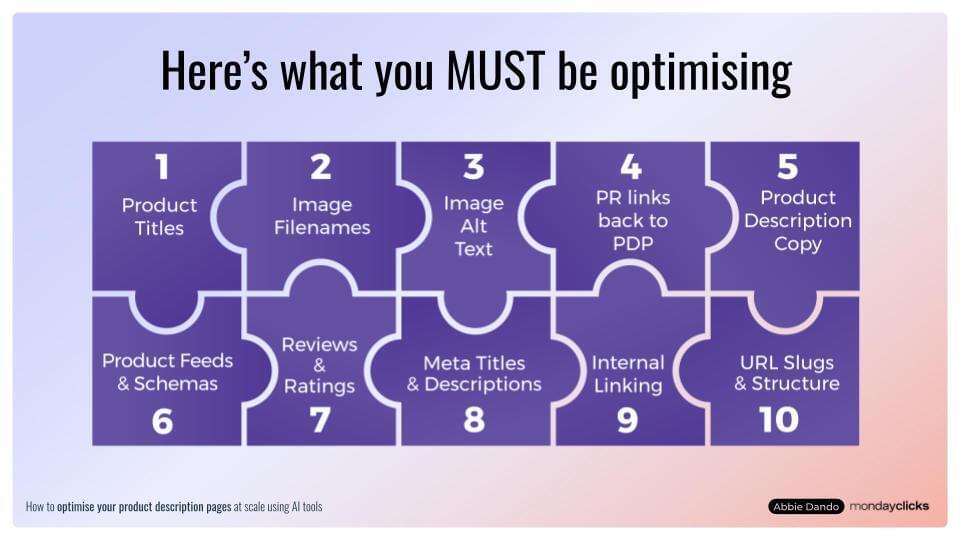
What To Optimise First (The High-Impact List)
Rather than trying to fix everything at once, focus on the areas that deliver the biggest return.
These are the essential elements every PDP needs in place to perform well across Google, AI Mode, LLMs, and your wider ecommerce ecosystem. They’re the “non-negotiables” - the pieces of the puzzle that make the biggest difference to visibility, trust and conversions.
1. Product Titles
Clear, descriptive, keyword-led titles that tell search engines and AI tools exactly what the product is.
2. Image Filenames
Descriptive, accurate filenames for all images and videos (no more IMG_2948.jpg).
3. Image Alt Text
Helpful, human alt text that describes the product clearly and accurately.
4. PR Links Back to PDPs
Digital PR and backlinks that strengthen product-level visibility and authority.
5. Product Description Copy
Expanded, customer-focused copy that answers real questions and supports AI Mode.
6. Product Feeds & Schemas
Clean, accurate feeds and structured data that power Google Shopping and AI results.
7. Reviews & Ratings
Visible, trustworthy reviews that heavily influence AI comparisons and conversions.
8. Meta Titles & Descriptions
Optimised metadata for traditional search, click-through rate and shopping visibility.
9. Internal Linking
Smart linking between PDPs, PLPs, guides and relevant content to strengthen context.
10. URL Slugs & Structure
Clean, logical, descriptive URLs that support crawlability and product understanding.
If your PDPs cover these ten areas well, you’re already ahead of most brands.
What Customers Care About Most (And What AI Uses to Compare Products)
AI search tools don’t just present products - they compare them. And the attributes they prioritise are very clear:
Price
Reviews
Shipping options
Return policies
If your PDPs don’t clearly communicate these, or if the information is buried too deep for AI tools to extract effectively, your product will lose the comparison - even if it’s technically the better option.
And here’s the biggest shift to be aware of:
If the information isn’t on your website somewhere, AI Mode simply won’t include your product.
That covers includes; FAQs, guides, expanded PDP copy, spec sheets, buying advice, comparison content - everything.

How To Optimise PDPs at Scale: The Six-Step Framework
This is the practical part - the structure we use when helping retailers improve their PDP process and scale content production with confidence.
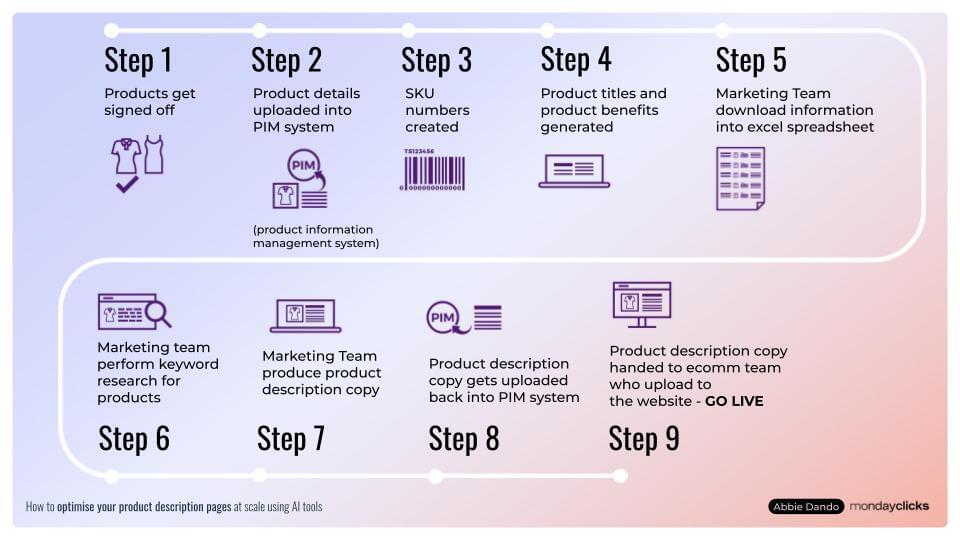
Step 1: Map Your Current Process
Before you can improve your PDP workflow, you need to know what it actually looks like today. Most ecommerce teams think they understand their process - but once everything is mapped out, it becomes clear why things feel messy, slow, or inconsistent.
Mapping the process removes the guesswork. It turns “we think this is where things go wrong” into “this is exactly where we’re losing time, quality or accuracy”.
Why Step 1 is important
You’ll finally see the bottlenecks causing delays or inconsistency.
You’ll uncover duplicated work, repeated tasks, and confusing handovers.
It reveals where product data becomes unclear or incomplete.
It highlights the real reason PDP quality is inconsistent (it’s rarely the writers).
It ensures any improvements you make are targeted, not random.
What to map
You want a clear, step-by-step view of how product information moves through your business:
Where the initial product data comes from (suppliers, PMs, spreadsheets, PIM).
How it gets to the content or ecommerce team.
What formatting or rework happens at each stage.
Who signs off the content (and how long they take).
Where SEO fits in - and where it currently doesn’t.
What happens after descriptions are written (QA, uploading, tagging).
Any tools or systems used (and which ones slow things down).
You cannot improve what you can’t see. This step alone uncovers most of the hidden issues.
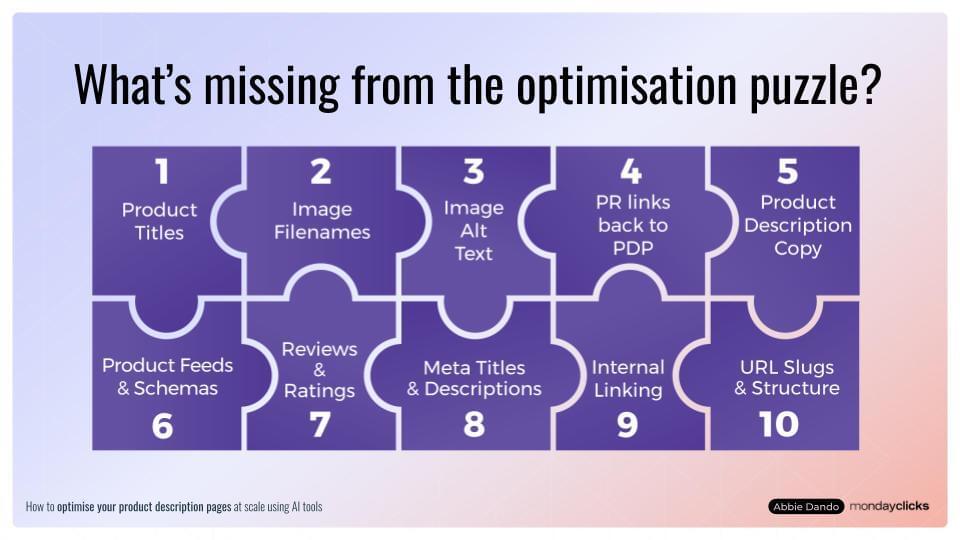
Step 2: Identify Missing Optimisation Puzzle Pieces
Once you’ve mapped your current process (Step 1), the next job is to figure out what’s actually missing from your PDPs - the gaps that are quietly holding your visibility, conversions and efficiency back.
Most brands assume their PDPs are “pretty good”, but when you break everything down, you realise huge chunks of the optimisation puzzle are missing or inconsistent. This step gives you clarity on exactly what needs fixing, what needs improving, and what you can ignore for now.
It’s not about perfection, it’s about knowing which pieces will make the biggest difference.
Why Step 2 is important
You stop guessing where the issues are and start seeing them clearly.
It helps you spot patterns (e.g., missing alt text, weak titles, inconsistent filenames).
It shows you where your PDPs fall short for AI Mode and LLMs.
It prevents wasted effort on areas that don’t move the needle.
It turns your “big messy PDP problem” into clear action points.
What to look for
Review a representative set of PDPs - across different categories, product types and complexity levels. For each one, check whether you have:
Optimised product titles
Clear feature → benefit copy
Enough descriptive detail for AI Mode
Structured specs (materials, size, key features)

Step 3: Conduct Keyword Research for Individual Products
This is the step most teams skip - and it’s a big reason PDPs underperform. For years, keyword research focused mainly on category pages. But AI search has completely changed that.
Customers are now searching for far more specific product attributes, and LLMs respond to those details. If your PDPs don’t reflect how people search at product level, AI Mode simply won’t surface your products.
Why Step 3 is important
AI search wants product-level detail, not just category-level.
Customers now search by feature, material, colour, size and “best for…” terms.
Better keyword research = better product titles, copy, filenames and metadata.
It reduces duplicate content across similar products.
It increases visibility in AI Mode, Google Shopping, and LLM comparisons.
What to research
You’re looking for the product-specific attributes people search for, such as:
Product type keywords
Material (e.g., “stainless steel”, “100% cotton”)
Colour and size variations
Fit, shape, purpose
Use cases (“best for camping”, “ideal for small kitchens”)
Pain points solved
Benefit-led terms (“waterproof”, “noise reducing”, “quick drying”)
Long-tail modifiers (“for beginners”, “under £50”, “lightweight”)
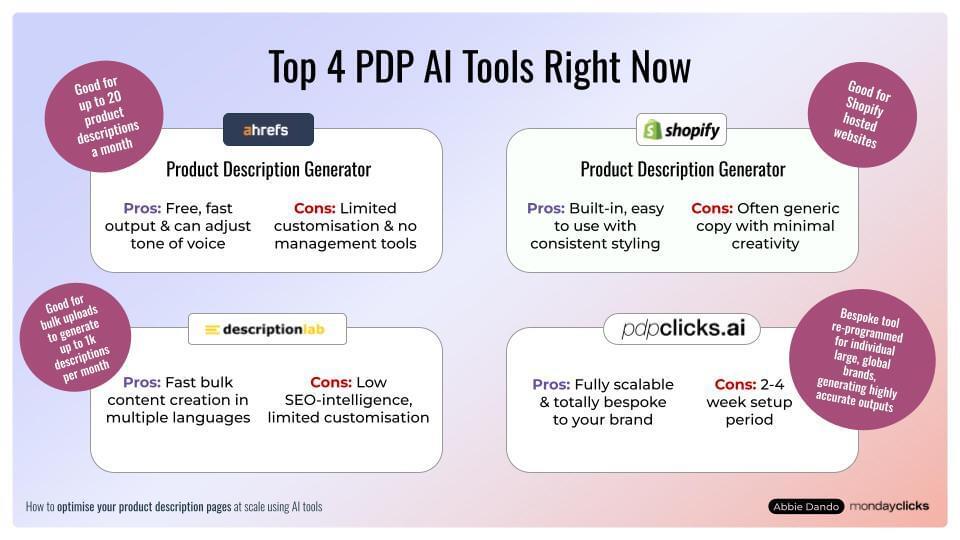
Step 4: Choose the Right AI Tool for You
Now that you know what’s missing and what needs improving, it’s time to find the tooling that actually helps you scale. The biggest mistake we see retailers make is choosing a tool before they understand their real needs.
By this point, you’ll have:
Clarity on your current process
A list of optimisation gaps
Insight into which tasks take the most time
Knowledge of which fields matter most for AI Mode and SEO
This makes choosing the right tool far easier. You’re no longer shopping blind, you’re matching features to real problems.
Why Step 4 is important
The wrong tool creates more work, not less.
The right tool gives you consistency, speed and structure.
Your PDP framework is only useful if the tool can follow it.
AI tooling can remove the repetitive tasks humans hate.
It future-proofs your workflow as product ranges grow.
What to look for in a tool
Does it support your actual PDP structure?
Can it handle your level of complexity (tech specs, variants, categories)?
Does it integrate with your current systems (Shopify, PIM, spreadsheets)?
Can it follow your tone of voice and naming rules?
Does it allow different templates per product category?
Can non-technical teams use it easily?
Is the pricing sensible for your volume?
Picking The Right AI PDP Tool
There are a lot of AI tools out there, but only a handful are genuinely useful for PDPs. Here’s a breakdown of the most common options, plus the strengths and limitations of each.
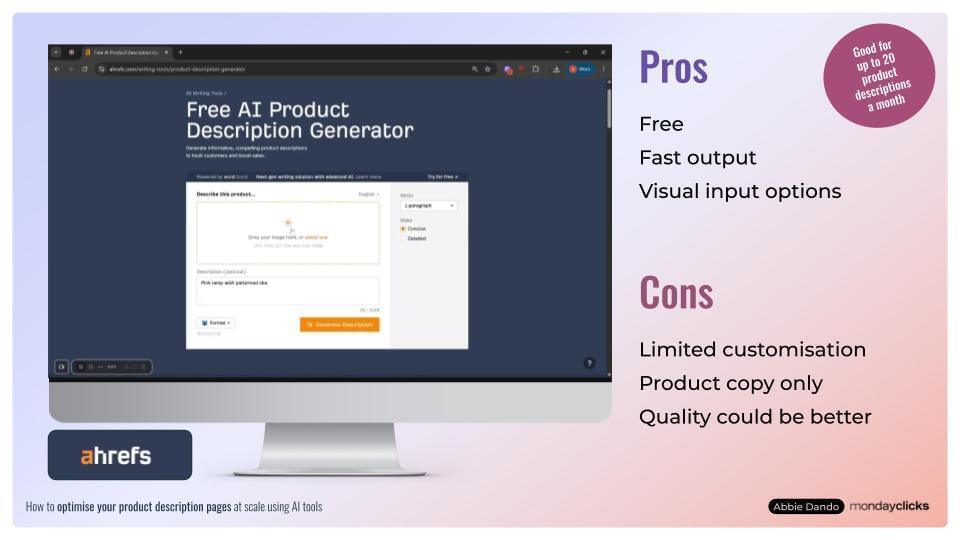
Ahrefs Product Description Generator
A lightweight, free and very simple tool that’s perfect for teams who are just starting to experiment with AI for PDPs. It’s not built for scale or complex catalogues, but it’s a great entry point if you need quick drafts, are dealing with low product volumes, or simply want to turn a blank page into something you can edit. Think of it as a “starter tool” for brands who want speed over structure.
Best for:
Small stores or early-stage brands
Quick drafting
Teams with low product volume
Marketers who already use Ahrefs
Strengths:
Free
Easy to try
Good for generating first drafts
Fast when you need “something over nothing”
Limitations:
Not suitable for large catalogues
Can’t handle structured data or complex product rules
No integration with PIMs or ecommerce systems
Requires manual editing for SEO consistency
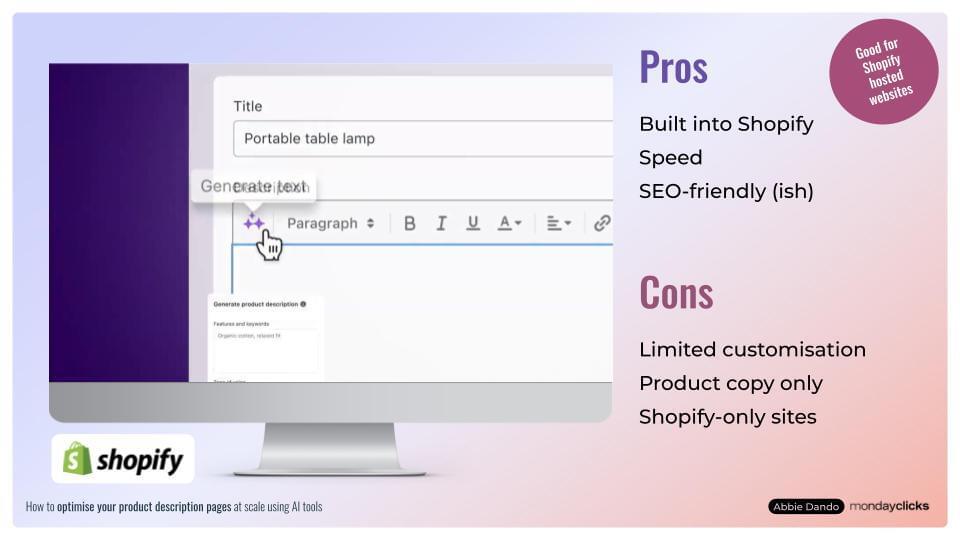
Shopify AI Product Descriptions
Shopify’s built-in generator is a handy option for brands working entirely within Shopify’s ecosystem. It sits directly inside your product workflow, meaning you can generate descriptions “in the flow” without switching tools. It’s best for smaller catalogues or growing brands who want to move fast, keep things simple, and avoid juggling extra software. It won’t replace a robust SEO workflow, but it’s brilliant for quick, tidy drafts.
Best for:
Shopify users
Brands producing small to mid-sized catalogues
Merchandising teams generating content within their workflow
Strengths:
Seamlessly integrated
Fast and easy to use
Good for “version 1” descriptions
Helpful for teams with limited resources
Limitations:
Not designed for SEO-heavy optimisation
Minimal control over structure and style
Output consistency varies
Not built for enterprise-level volume
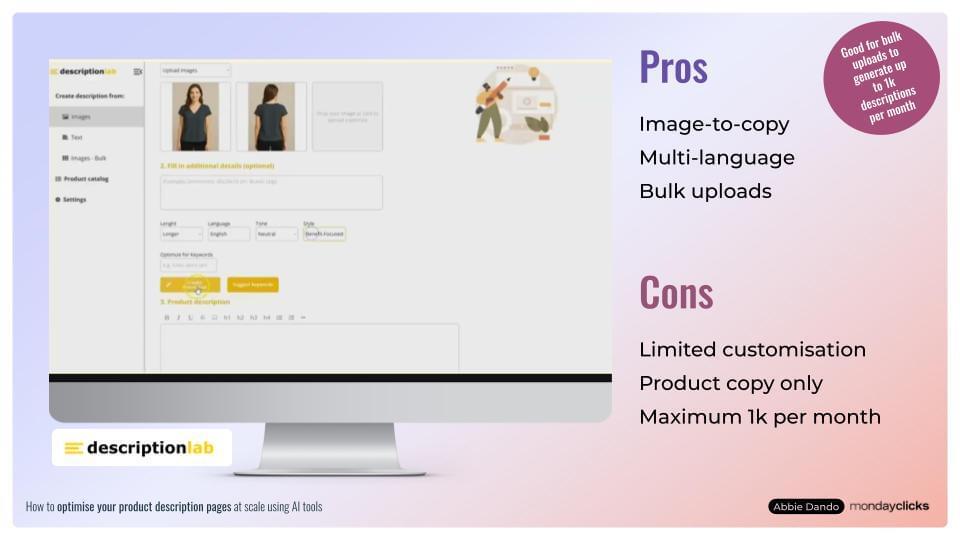
Description Lab
A solid, mid-level tool built for brands producing product descriptions on a regular basis but who don’t need enterprise-level complexity. Description Lab works best when your catalogue is predictable - similar product categories, repeatable formats, clear feature/benefit structures. It gives you structure without overwhelming you, making it ideal for retailers who want a step up from basic generators but don’t need deep system integrations.
Best for:
Teams producing 100–500 PDPs a month
Brands needing repeatable layouts
Mid-sized ecommerce retailers
Strengths:
Clear templates
Faster than writing manually
Handles benefits + features formats well
Ideal for simple-to-medium complexity products
Limitations:
Not designed for deep technical specs
Access to custom rules can be limited
Requires manual oversight for accuracy
Less suitable for multi-category retailers with lots of variation

PDPClicks.ai (Built by Monday Clicks)
A flexible, enterprise-ready tool designed specifically for retailers with large catalogues, complex data, PIM systems and category-level variations that most AI tools can’t handle. Instead of forcing you to change your workflow, PDPClicks.ai is built to sit on top of your existing processes, adapting to your spreadsheets, your systems, your approvals and your SEO rules. It’s built for speed, consistency and accuracy at scale, giving teams a way to produce optimised PDPs without drowning in manual work.
Best for:
Enterprises producing 500+ PDPs monthly
Teams using PIMs and spreadsheets
Retailers with large, varied catalogues
Generating consistent, SEO-friendly descriptions
Handling custom rules per category
Reducing manual clean-up work
Scaling content without sacrificing quality
Strengths:
Custom-built to your workflow (not one-size-fits-all)
Handles complex, category-specific rules easily
Works alongside existing systems
Flexible for global teams
Low monthly cost compared to many enterprise tools
Available self-serve or fully managed
Adapts as your catalogue and processes evolve
Limitations:
Unnecessary for small stores or simple product sets
Takes 2 - 4 weeks to setup
If you’re exploring AI for product content, our bespoke PDPClicks.ai tool can plug straight into your existing process and helps you generate accurate, consistent, search-friendly PDPs without reinventing everything behind the scenes.
Want to know more? Let’s chat.
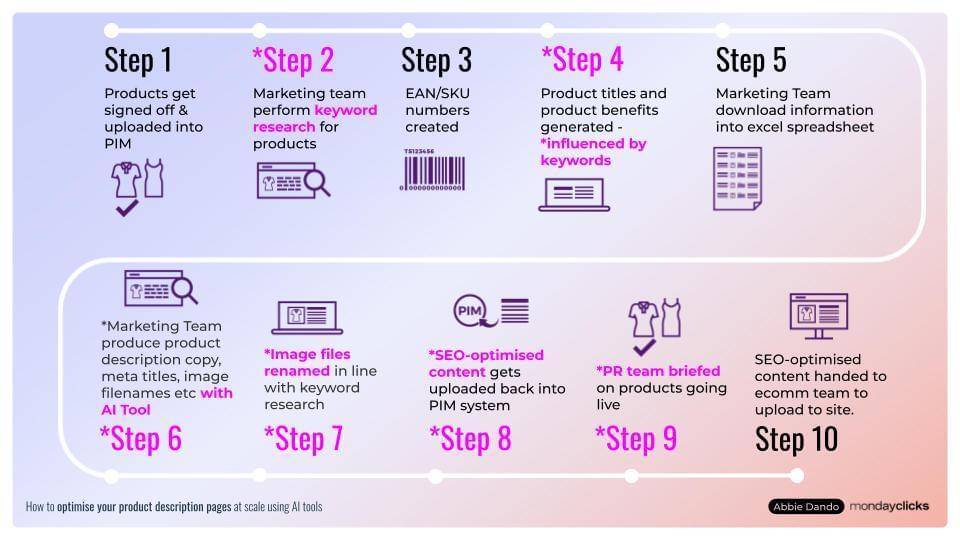
Step 5: Develop Your New Process
Once you’ve chosen your tool, it's time to rebuild your PDP workflow around it. This doesn’t mean starting again from scratch - it means refining the process so it’s smoother, faster, and aligned with both your framework and chosen tool.
This is where everything starts to click.
Why Step 5 is important
AI tools don’t fix broken processes, they amplify them.
A great process turns your PDP framework into reality.
It prevents teams falling back into old habits.
It reduces errors, inconsistencies and duplicated work.
It gives every stakeholder clarity on their role.
What the new process should cover
Where product data enters the workflow
Who enriches it (and what needs enriching)
Where SEO fields are added
At what point the AI tool is used
Who edits or approves the AI output
How the content gets uploaded or syndicated
How different categories are handled
How feedback loops work

Step 6: Track, Review & Refine
PDP optimisation isn’t something you do once and forget about. Search changes. AI changes. Customer expectations change. Your catalogue changes. Your tooling changes. Your team changes.
Tracking and reviewing ensures your PDPs stay strong - not just at launch, but long-term.
Why Step 6 is important
It shows whether your efforts are actually working.
It helps catch new issues before they spread across thousands of PDPs.
It keeps your framework and process relevant.
It helps you spot patterns (e.g., a category that keeps slipping).
It allows your tooling to improve over time.
What to track
Focus on signals connected directly to PDPs:
Visibility across AI Mode + Google Shopping
Rankings for product-level keywords
Product impressions vs clicks
Add-to-basket rate
Conversion rate
Time spent on page
Returns rate (linked to product clarity)
Number of PDP edits or rework required
Production time per product
Quality score of output from your AI tool
PDP Optimisation Checklist - 6 Essential Steps
A simple checklist to make optimise your product descriptions pages:
Map Current Process
Identify Missing Puzzle Pieces
Keyword Research
Find the Right AI Tool
Develop New Process
Track, Review and Refine
Nail these six steps and you’ll transform PDPs from a never-ending headache into a streamlined, scalable system that actually works.
The Easiest Way to Optimise PDPs at Scale
If you’re looking for the best and easiest way to make your PDP workflow smoother, faster and far less stressful, then you need to get in touch and let us do the hard work.
Whether you need a full process audit, a scalable content framework, or just some support choosing the right AI tool, we can help you and your teams wherever you’re feeling the pressure.
Sound good? Let’s chat.
Get in touch
© 2022 Monday Clicks | All rights Reserved | Privacy Policy

